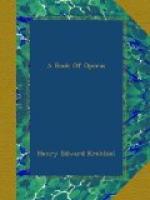which differentiate it from the music of Verdi’s
other operas and the works of his predecessors and
contemporaries, “Aida” is a companion
of all the operas for which Meyerbeer set a model when
he wrote his works for the Academie Nationale in Paris—the
great pageant operas like “Le Prophete,”
“Lohengrin,” and Goldmark’s “Queen
of Sheba.” With the last it shares one element
which brings it into relationship also with a number
of much younger and less significant works—operas
like Mascagni’s “Iris,” Puccini’s
“Madama Butterfly,” and Giordano’s
“Siberia.” In the score of “Aida”
there is a slight infusion of that local color which
is lavishly employed in decorating its externals.
The pomp and pageantry of the drama are Egyptian and
ancient; the play’s natural and artificial environment
is Egyptian and ancient; two bits of its music are
Oriental, possibly Egyptian, and not impossibly ancient.
But in everything else “Aida” is an Italian
opera. The story plays in ancient Egypt, and
its inventor was an archaeologist deeply versed in
Egyptian antiquities, but I have yet to hear that
Mariette Bey, who wrote the scenario of the drama,
ever claimed an historical foundation for it or pretended
that anything in its story was characteristically
Egyptian. Circumstances wholly fortuitous give
a strong tinge of antiquity and nationalism to the
last scene; but, if the ancient Egyptians were more
addicted than any other people to burying malefactors
alive, the fact is not of record; and the picture as
we have it in the opera was not conceived by Mariette
Bey, but by Verdi while working hand in hand with
the original author of the libretto, which, though
designed for an Italian performance, was first written
in French prose.
The Italian Theatre in Cairo was built by the khedive,
Ismail Pacha, and opened in November, 1869. It
is extremely likely that the thought of the advantage
which would accrue to the house, could it be opened
with a new piece by the greatest of living Italian
opera composers, had entered the mind of the khedive
or his advisers; but it does not seem to have occurred
to them in time to insure such a work for the opening.
Nevertheless, long before the inauguration of the
theatre a letter was sent to Verdi asking him if he
would write an opera on an Egyptian subject, and if
so, on what terms. The opportunity was a rare
one, and appealed to the composer, who had written
“Les Vepres Siciliennes” and “Don
Carlos” for Paris, “La Forza del Destino”
for St. Petersburg, and had not honored an Italian
stage with a new work for ten years. But the suggestion
that he state his terms embarrassed him. So he
wrote to his friend Muzio and asked him what to do.
Muzio had acquired much more worldly wisdom than ever
came to the share of the great genius, and he replied
sententiously: “Demand 4000 pounds sterling
for your score. If they ask you to go and mount
the piece and direct the rehearsals, fix the sum at
6000 pounds.”




